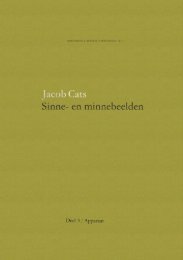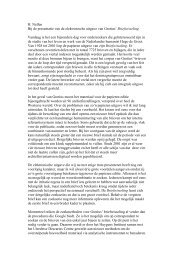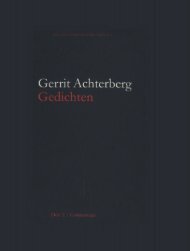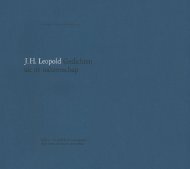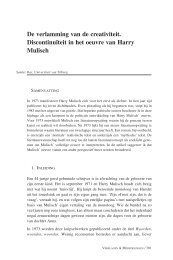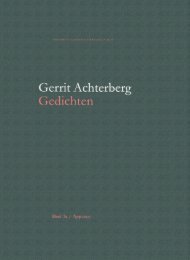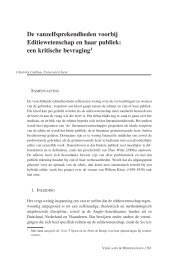Download deel 2 - Textualscholarship.nl
Download deel 2 - Textualscholarship.nl
Download deel 2 - Textualscholarship.nl
Create successful ePaper yourself
Turn your PDF publications into a flip-book with our unique Google optimized e-Paper software.
172<br />
"mise en abyme" - of welke suggestieve term men hier ook wil laten<br />
aanrukken - doet zich vaker voor bij Leopold, zoals in `Oivov ' , `De<br />
molen' , `Regen', 92 en kan verschillende effecten hebben. Ze kan in<br />
dienst staan van het gepretendeerde transcenderende karakter van het gedicht:<br />
de circulariteit suggereert het 'oneindige'. Of ze roept, in tegenstelling<br />
met het genoemde, een fundamentele paradox op, een aporie,<br />
een onmogelijkheid, een met het transcenderende in oppositie staande<br />
geslotenheid. 93<br />
92 Kamerbeek eet h f > voorzover rz r ikweet, et het ee eerst st op pdit ve verschijnsel schi l sel b bij Leopold<br />
l p ggewezen<br />
zie zijn l `Leo p olds "Eén dru pp el wijn"'). l "Dit eenzelvig g denken" (uit 0 iv ou tva 'v ara -<br />
,ta yuóv verwijst naar het `denken' zoals zich dat in het gedicht g openbaart. p Kamerbeek<br />
spreekt p in dit verband van een speciaal p gebruik g van het pronomen p dit: dit is een reflexief<br />
pronomen. ronomen. Naar mijn idee echter is dit - hoezeer het ook op p een speciale p wijze wijz wordt<br />
gp east - een ` ewoon' g deiktisch voornaamwoord: dit verwijs verwijst immers naar iets (uit de<br />
werkelijkheid), alleen is datgene g waar het pronomen p naar verwijst het gedicht g waarin dit<br />
bevat is zelve.<br />
Het verschijnsel van 'wederkerigheid' g of `reflexiviteit' - waarbi waarbij sprake rake is van een cir-<br />
betekenisproces, p van een naar zichzelf terugverwijzen ^ J - dient niet beperkt p te wor-<br />
den tot het `reflexief'ronomen p ebruik. g Het is algemener g (zie noot 80, noot 65 en noot<br />
93 93). Het lijkt l te maken te hebben met de overeenkomst in `vorm' en 'inhoud': de<br />
`vorm' hetedicht g heeft als `inhoud' het gedicht g zelf. Zie omtrent het verband van<br />
`wederkers 'wederkerigheid' g en immanente ppoetica ook Kamerbeek: 'Op `0 zoek naar een definitie van<br />
het symbolisme': Y ``het zal duidelijk duidelijk zijn dat `immanente poëtica' p bij uitstek het middel<br />
is, om de ... relatie tussen 'symbolisant' Y en 'symbolise Y te bewerkstelligen" g (p. p 773). 3 De<br />
'wederkerigheid' g is niet tot de literatuur beperkt. p Het zou in verband gebracht g kunnen<br />
worden met een begrip gp als "self-reference", dat een rote rol grote speelt pin<br />
Hofstadter: Gó-<br />
d del, l Bach. V Vgl. 1. ook de volgende g passage p g uit The classical style y van Charles Rosen<br />
naar aa<strong>nl</strong>eiding g van Beethovens ppianosonate opus p 106 in Bes("Hammerklavier"): Deze<br />
son a te is ``a work which extends and even, to some extent, , strains) the relation of musi-<br />
ca 1 form fo a and d co content te in a specific p way. Y The content - the subject-matter subject-matte - of the<br />
is the nature of the contemporary p rY musical language. The work of art<br />
which is literally Y about its own technique q is almost too familiar by Y now: the poem p about<br />
poetry oer itself (like most of those by YMallarmé), ^ film in which the principal p p subject- lect<br />
matter is cinematic technique q and the cross-references to other films, ^ the painting p gwhich<br />
actually Y attempts p to depict p the process p of projecting pl ro g sp space upon pon aflat surface or which refer<br />
s, not outside o itself, but directly yto the medium of paint. p This paradoxical p interchange g<br />
of form and content is a normalrocess p of any Y art, ^which naturally Y tends to displace p the<br />
wei weight h of significance sg away Y from that which is si signified gnified towards the sign. g But music,<br />
where denotationsat is oonce pprecise and totally Y unspecific, presents resents pa specialproblem. pro<br />
If<br />
we omit i the occasional imitative effects ... and the direct conventions of pathos, p we can<br />
deny Y neither that m music i has as significance s g nor that it signifies g most clearly Yand<br />
most often<br />
itself.<br />
Beethovens sharpens ^en the t focus o of this self-reference, ^ as the introduction to the fugue g of<br />
the h Hammerklavier makes peculiarly eculiarl ex licit. p [Volgt geen technische beschrijving l g hoe dit<br />
gesc hiedt. A more open p and direct statement about classical counterpoint ^ an and its stor hii-<br />
cal relations p g style Y could not be made within to a strictly Ythe"<br />
musical language."<br />
(p. 434.)<br />
93 Lucie ' n Dal " 1enbach (Le e récit spéculaire) s geeft g een indeling g van diverse typen Yp `mise en<br />
ab Y me ' - zic zichdaa daarbij b l vvooral<br />
richtend baserend) op p verhalende teksten. De twee door



